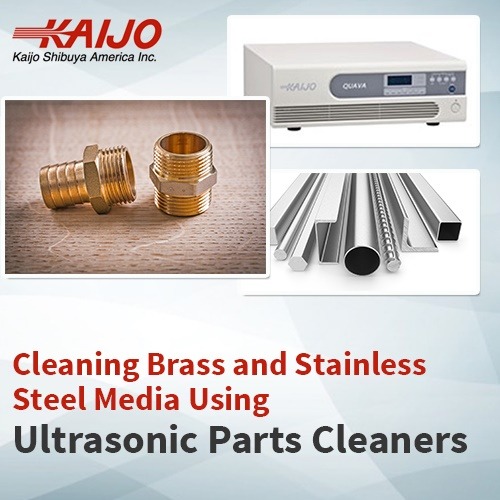Cleaning Brass and Stainless Steel Media Using Ultrasonic Parts Cleaners
October 30, 2017
 Ultrasonic parts cleaners use ultrasonic frequency generators and transducers to create tiny bubbles in water or a mild detergent solution. The bubbles produce a microscopic scrubbing action that is highly effective in removing surface contaminants from solid metal surfaces such as brass and stainless steel. Traditional cleaning methods using harsh chemicals and mechanical scrubbing are more labor intensive and they don’t clean as well as ultrasonic parts cleaners. Companies that have to clean brass and stainless steel parts can reduce cleaning times, reduce production costs and improve cleaning performance by switching to ultrasonic cleaners for their cleaning applications.
Ultrasonic parts cleaners use ultrasonic frequency generators and transducers to create tiny bubbles in water or a mild detergent solution. The bubbles produce a microscopic scrubbing action that is highly effective in removing surface contaminants from solid metal surfaces such as brass and stainless steel. Traditional cleaning methods using harsh chemicals and mechanical scrubbing are more labor intensive and they don’t clean as well as ultrasonic parts cleaners. Companies that have to clean brass and stainless steel parts can reduce cleaning times, reduce production costs and improve cleaning performance by switching to ultrasonic cleaners for their cleaning applications.
How Ultrasonic Technology Cleans Brass and Stainless Steel
For robust parts such as those made from brass and stainless steel, ultrasonic cleaners operating at the lower ultrasonic frequency ranges are the most effective. Ultrasonic generators for 26 kHz or 38 kHz create energetic bubbles that form and collapse in time with the cleaning frequency. When they collapse near the surface of the metal, they release bursts of energy that dislodge dirt particles but don’t harm the solid metal surface.
For metal parts covered in oil or grease, the effectiveness of ultrasonic cleaners can be increased by adding a mild detergent to the water bath and by heating the cleaning solution slightly. Heating softens the oil and grease and the detergent helps dissolve it. The ultrasonic bubbles penetrate wherever there is cleaning solution so cleaning is rapid and complete.
Benefits of Using Ultrasonic Cleaners
When a facility switches from traditional cleaning methods to ultrasonic cleaning, it can expect substantial benefits from making the change. With environmental concerns becoming more important, eliminating the use of harsh chemicals provides a big advantage and helps increase worker safety as well. Cleaning with ultrasound is quick, effective and convenient and does not require constant monitoring.
Instead of spending money on expensive cleaning chemicals, facilities that use ultrasonic parts cleaners only have to buy small quantities of mild solvents or detergents. The costs associated with chemical storage, chemical handling and toxic waste disposal disappear as well. Often chemical baths do not completely remove surface dirt from the metal parts and mechanical scrubbing is required. When carried out manually, high labor costs are incurred due to the time-consuming nature of the work. When scrubbing by machine, costs include the purchase of the machine and its maintenance. Switching to ultrasonic cleaning avoids all these costs and provides substantial savings.
In addition to incomplete cleaning, traditional cleaning methods suffer from limitations on where they can clean. Parts with complex shapes are hard to clean with scrubbing and bolt holes, crevices, slots and internal cavities may be inaccessible. Ultrasonic cleaning produces the cleaning bubbles wherever cleaning solution is present. As long as the water or mild detergent solution is in contact with the part surface when the part is immersed in the cleaning bath, the ultrasonic bubbles will scrub the inside of holes and hard-to-reach places. Parts are cleaned inside and out, quickly and reliably.
How Kaijo Can Help Make the Switch
Kaijo has extensive experience using ultrasonic cleaning technology in various industry applications and has in house expertise to advise customers how best to clean their brass and stainless steel parts. The company offers free consultation and can advise facility managers and owners how best to solve specific cleaning problems. Backed by its complete line of ultrasonic cleaning systems and equipment, Kaijo can make recommendations on solutions for particular cleaning applications. Typical results of a switch to ultrasonic cleaning include lower overall operating costs, increased productivity due to reduced cleaning times and improved output as a result of better cleaning performance.





